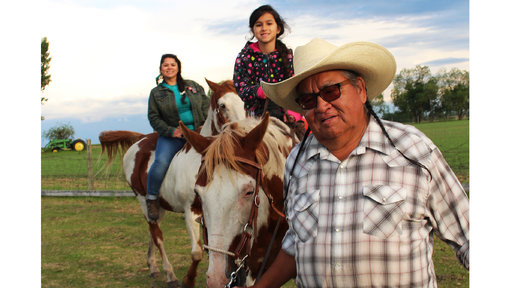By Chevi Rabbit, Local Journalism Initiative Reporter
(ANNews) – On June 24, Pope Frances came to Maskwacis, to deliver an apology on indigenous soil at the former site of one of Canada’s largest Indian Residential Schools on Ermineskin Cree Nation.
Patrick Buffalo is a former leader and well respected member of the Samson Cree Nation, who has dedicated his life to healing and wellness through his horse therapy ranch where agencies and people with post-traumatic stress come to be helped with their relationship building.
In an interview, Buffalo offered his insights on the Papal visit. He said that he personally, did not need to hear an apology from the Pope because he started his own healing journey almost 30 years ago as a form of decolonization.
“I started my healing journey years ago and I didn’t need the Pope’s apology,” he said. The Pope is here to apologize and first and foremost, it is about healing, he explained, and some people believe they need somebody else to feel better.
Then he added, the messaging behind the Pope’s visit, says that now that an apology has been delivered, Indigenous peoples of Canada can start healing, but for some, like him, it started 30 years ago.
For others, the healing can possibly begin now but the healing journey is a personal choice that each Indigenous person must make for themselves.
“People believe in forgiveness; some people believe in making amends and some people believe in an apology,” said Buffalo. “They believe somebody will make them feel better and other people do need others to make them feel better.
“It’s all a choice.”
For him, the Pope represents The Catholic Church and a Christianity-led colonization, with efforts towards forced assimilation.
“Many of our people in Maskwacis spoke about decolonization, and some of our leaders and members are so colonized that they do not recognize that Christianity is the core of colonization,” said Buffalo.
“Some of our people’s colonization mindset still honours and believes in a Great White Pope, and that it takes a Great White Pope. But it reflects where the community is in terms of colonization and decolonization.”
“We have leaders who go to church and do the rosary once a week – they are colonized. That’s what the residential schools were designed to do, kill the Indian and save the child,” explained Buffalo.
“Yet so many people are stuck in that mindset of our victimhood,” he added. “My definition of healing has always been taking ownership of who you are and what you create.
“There is no room for victimhood. No room for blame either. People have to take ownership and make choices.”
He said, “The whole definition of the Pope being here is healing. What we need to do is let go of the heaviness that we carry based on past experiences.”
Buffalo offers advice on letting go of past trauma, and that’s recognizing that anger is a secondary emotion, don’t hide it, bring it front and centre, feel it, and decide if you can let it go. Verbalize what hurt you and say I let this hurt go, I let this disappointment go.
There are many paths to wellness and Buffalo, a facilitator of healing, does this work in Maskwacis with Horse Therapy, based on the therapeutic power of building connections and communing with horses.
He also offers this program through Maskwacis Mental Health; he recommends it for people in active addiction, PTDS, childhood abuse victims, abuse victims, and people who have experienced trauma in their lives.
Buffalo invites our readers to watch Breaking Stigmas.



Be the first to comment on "Reflections on the Pope’s apology – another perspective on healing"